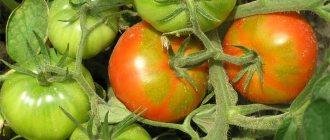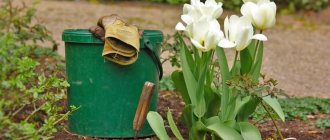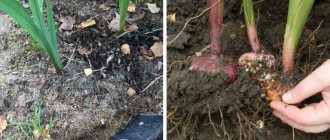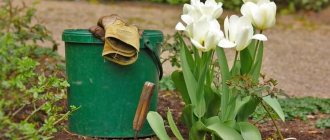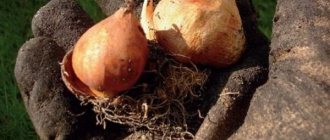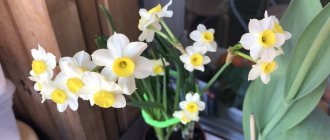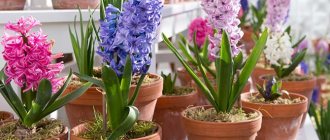Hyacinths bloom beautifully and look great in a pot, but the question often arises of what to do with hyacinths after flowering.
Dear readers!
For you, we have created communities on social networks in which useful articles and interesting ideas are published several times a day! Subscribe and receive useful content in a convenient format! The simplest option for what you can do is to throw out the bulb, but it is much nicer to give the flower a second life.
We will tell you in today's article what actions need to be performed with the flower after all the petals have fallen.
Where to start caring for hyacinth in a pot after flowering
If you provide the hyacinth with proper care, then there is a high probability that you will soon be able to see the flowering process again.
First of all, you should try to save the rhizome (but not the plant itself above the ground) by carrying out simple actions after flowering.
As soon as the hyacinth has faded, it, along with the fading leaves, must be taken out of the store container and shaken with an earthen ball. In this case, you should pay attention to the appearance of the bulb and its bottom in order to recognize rotting.
Then you need to separate the bottom part.
Varieties
Hyacinth is a herbaceous plant, perennial. Belongs to the lily family. About 400 varieties are known. Grows up to 40 cm. The bulb produces a thick peduncle with inflorescences of bright flowers, collected in spike-shaped racemes. The leaves are narrow and linear. Flowers come in different shades: white, blue, pink, orange and coral.
Hyacinth/Hyacinth
Today, the most popular varieties are Anne Marie, Queen of Pinks, Madame Hutzbenzak, Bismarck, and Grand Lila. The French-Roman variety Festival is unusually beautiful; it produces many flower stalks from the bulb.
Step-by-step instructions for caring for hyacinth at home
To revive hyacinth and continue to enjoy its blooms, you must follow certain recommendations. The first method includes the following steps:
- As soon as flowering has stopped, do the following: cut off the peduncle (leaving about 12 cm), leave the leaves.
- Watering should be gradually reduced to a minimum. It is necessary to water only when the soil dries out. But watering should not be as abundant as with a flowering plant, but with longer breaks.
- Over time, the leaves will turn yellow. Carefully complete watering and wait until the leaves are completely dry.
- Once the leaves are dry, they should be trimmed and the bulbs removed. When removing the head from the pot, you must be careful and free it from the soil.
- It is recommended to dry the bulb in a warm, dry and ventilated area. Thus, planting material should be stored until the next planting. For this purpose, you can choose a cardboard box or other container, but not in film.
Before sending the bulbs to dry, it is recommended to process them. Doing this in the refrigerator is prohibited.
The second way to care for faded hyacinth:
- Peduncles with faded flowers are cut off. There is no need to do too much pruning; it is recommended to leave about 12 cm. The leaves should dry out on their own. The plant should smoothly enter the dormant phase.
- Now you need to move the plant to a larger container. The earthen lump must be left behind. In such conditions, the bulbs will develop on their own, and young plants will appear next to them.
- The plant should be left in a bright and ventilated area. After transplantation, hyacinth should be watered in doses. There is an opinion that this must be done through a pallet. A couple of weeks after transplanting, you can add some fertilizer to the soil.
- Now you need to decide: the plant will remain in a pot on the windowsill, or it will migrate to open soil in the garden bed.
- When the leaves are completely dry, stop watering. The bulb is freed from the soil, cleaned, dried and stored until it is time to plant it in the ground.
- Storage is allowed in the pantry or under a cabinet. The storage location should be dark and not hot. The bulbs can be stored for up to three months.
Proper forcing of flowers
The choice of high-quality planting material is very important for successful flowering
The success of forcing hyacinths largely depends on the plant variety and how well the bulb is chosen. There are a number of requirements for planting material.
Preparing the bulb
In order for the hyacinth to bloom in a pot, it is necessary to properly prepare the bulb. This applies only to the seed that is dug out of the ground. If an onion is bought in a retail chain, it is known that it has passed all the stages of preparation listed below.
- Bulbs intended for germination are dug up in mid-summer. They are cleared of soil and kept in conditions of high humidity at +30°C for 14–15 days.
- Next, the temperature is reduced to +25°C and the seed is kept for two weeks.
- Then, until planting, the bulbs are kept at +17°C.
Boarding time
The rooting period of the bulb is 6–10 weeks, depending on the variety and quality of the seed. If they want to grow flowers by a certain time, they are guided by practice-tested deadlines:
- flowers for the beginning of the new year and Christmas - planting in the first half of September;
- by March 8 - at the end of October.
Soil preparation
Any small containers are suitable for planting hyacinths: plastic cups, deep disposable plates, pots, jars.
For planting you will need a certain list of materials and tools.
- A drainage 10–20 mm thick is formed at the bottom. These can be small pebbles mixed with sand.
- Next, add a layer of soil. To grow hyacinths, you cannot use sour. The optimal choice is a mixture of equal parts of leaf soil, turf and compost, with a little sand and peat added. You can also mix lowland peat and coarse sand in equal proportions. Another option is to buy ready-made soil mixture at a gardening store.
- A 5–7 mm layer of sand is poured onto the substrate. This is a precaution to prevent the plant's roots from rotting.
Landing
For forcing, deep pots 14–20 cm high are used. As the bulb grows, it will inevitably increase and protrude above the soil surface. Therefore, you need to plant it in the upper third of the pot, and not at the level of its edges.
For commercial purposes, hyacinths are grown in small boxes, but each bulb is in a separate cell
The planting process consists of several stages:
- lightly press the bottom of the bulb into the ground (do not screw it in!);
- sprinkle with earth so that the upper part of the bulb is free and protrudes above the ground level;
- It is permissible to sprinkle the top part with dry sawdust.
Attention! If several bulbs are planted at once, they should not touch each other. In this case, the planting should be quite crowded. The optimal distance between them is 2–2.5 cm.
Rooting period
After the flower is planted in a pot, it needs a period of rest. At this time, the following conditions are provided:
- complete lack of lighting;
- air temperature +5–7°С;
- normal humidity.
During the rooting period, constantly ensure that the soil in the container is moderately moist. Drying out is unacceptable. For the purpose of disinfection and fertilizing, the soil is watered with a solution of potassium permanganate and sprinkled with wood ash. The duration of the rest period is 2–2.5 months.
Storage space for pots:
- bottom shelf of the refrigerator;
- cold loggia;
- basement or cellar;
- garage.
The rest period is otherwise called “cold”. This is a mandatory step in the process of forcing bulbous flowers.
The final stage of forcing
–
After two months after planting, they begin to regularly check whether sprouts have appeared. Once they reach a height of 2–2.5 cm, the pots containing the seed move to a cool, well-sun location. Optimally - on the windowsill. The flower should remain here throughout the next month. In the first week after the end of the cold period, it is advisable to cover the pots with a paper cap.
Attention! During this period of plant growth, the air temperature should not exceed +15°C.
At the end of this stage, the buds appear and the pot is transferred to the place where it will be permanently located. Next, wait for the start of flowering. Hyacinths do not tolerate excess moisture well, so they need to be watered regularly, but in moderation.
Forcing in water
To obtain a “water” flower, before planting, all the same steps are followed as when growing in a pot. It is important to choose the right water container. It should be such that the bulb does not sink in the liquid, but comes into contact with it with its lower, root part. In order to achieve this, you can use various devices. A good choice is narrow glasses.
The water must be clean: rainwater or filtered. The container must be wrapped in dark paper and the plants should be sent to a cool place to go through the cold period. All this time, monitor the fluid level and top it up in a timely manner. After the first roots appear, fertilizer is added. For example, "Kornevin".
How to care for a plant when it has bloomed
If we talk about planting in the ground, then it is permissible to leave the bulbs in the ground in one place for five years in a row. After this time, they will become larger, and they can be dug up and planted with children.
But experienced gardeners advise not to leave flowers in the ground for many months, since after winter they may stop blooming. It is recommended to remove the bulbs, sort, inspect, disinfect and store in a cool and dark place.
Digged or purchased bulbs must first be dried. This should be done indoors at a temperature of about +23 degrees. After this, they need to be shaken off the ground and the unnecessary husks removed. If small onions appear, they should be separated carefully.
After this, the bulbs are distributed in a cooler place. In this case, the temperature should gradually decrease. By the end of summer, the bulbs should be stored at a temperature no higher than +18 degrees.
There should not be high humidity in the room; good ventilation should be provided. At the end of summer, the bulbs are planted in the ground for the winter.
Autumn planting
The flowerbed is prepared in advance, a month or two in advance. The soil is well dug to a depth of 20-30 cm, since the roots of these plants go deep. Adding compost or rotted manure to the soil for digging (but no later than a month before planting) has a beneficial effect on flowering. You can also refill the soil with autumn complex fertilizer.
In central Russia, it is recommended to plant hyacinths in the first ten days of October. If planted early, especially if the autumn is warm, hyacinths may begin to grow and die from frost. And 2-3 weeks before frost, the bulbs will have time to take root, but not germinate. For this, the optimal planting period is considered to be the end of September - the beginning of October.
In the fall, as a rule, and September, the bulbs are planted in the ground to a depth of 1.5 - 2 cm. In general, it is believed that the planting depth of the bulb depends on the diameter. Large specimens are buried 18-20 cm, measured from the bottom. On clay soils, planting should be shallower. You can pour a 2-centimeter layer of sand at the bottom of the hole; hyacinths like it.
The bulbs are lowered into the hole bottom down, sprinkled with soil about half the bulb, and then with soil.
Care in open areas
Now let's talk about what to do with hyacinths after flowering if they grow right in your open ground.
After the hyacinth has been planted in the ground, it must be regularly weeded, watered, fertilized and loosened. It must be borne in mind that hyacinths do not like weeds. As soon as sprouts begin to appear, you need to start fertilizing the soil. It is better to give preference to saltpeter (27 grams per 1 square meter).
You should fertilize the soil again when the buds appear. The spaces between flowers in one row or between rows are fertilized. After fertilizing has been applied, it is necessary to water the crops.
The flowering period of hyacinths quickly ends, and after it it is necessary to continue to moisturize the root system. In order for the bulbs to become stronger after flowering, you must continue to fertilize and water regularly.
Personal experience: What NOT to do!
Several years ago I gave my mother, sister and myself a gift
